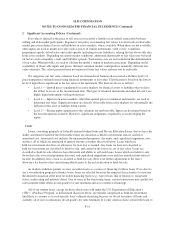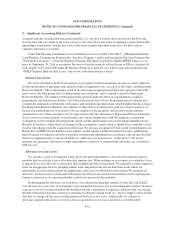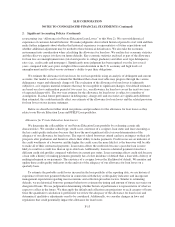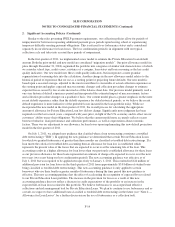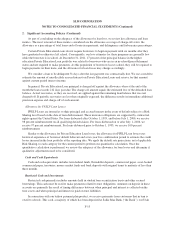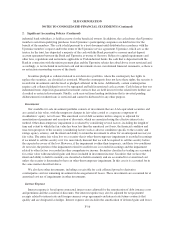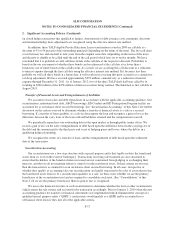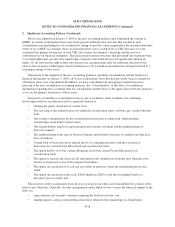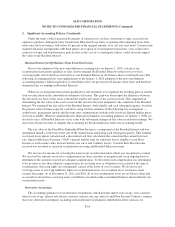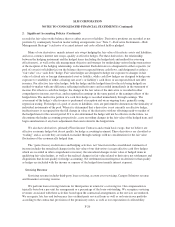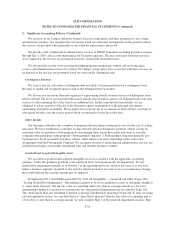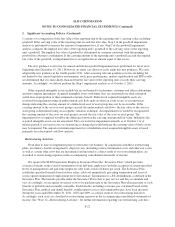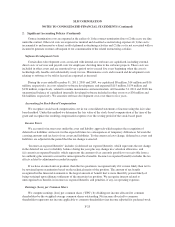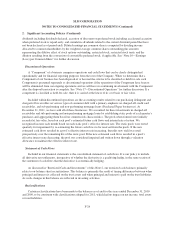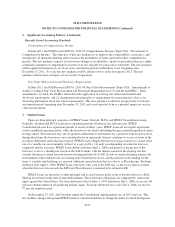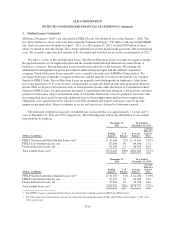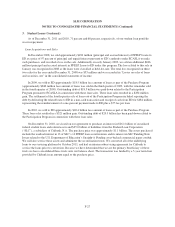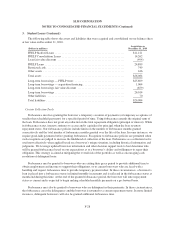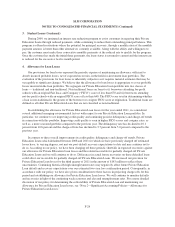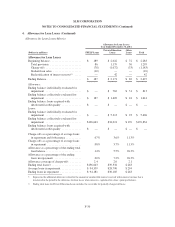Sallie Mae 2011 Annual Report Download - page 129
Download and view the complete annual report
Please find page 129 of the 2011 Sallie Mae annual report below. You can navigate through the pages in the report by either clicking on the pages listed below, or by using the keyword search tool below to find specific information within the annual report.SLM CORPORATION
NOTES TO CONSOLIDATED FINANCIAL STATEMENTS (Continued)
2. Significant Accounting Policies (Continued)
recorded at fair value on the balance sheet as either an asset or liability. Derivative positions are recorded as net
positions by counterparty based on master netting arrangements (see “Note 7—Derivative Instruments—Risk
Management Strategy”) exclusive of accrued interest and cash collateral held or pledged.
Many of our derivatives, mainly interest rate swaps hedging the fair value of fixed-rate assets and liabilities,
and cross-currency interest rate swaps, qualify as effective hedges. For these derivatives, the relationship
between the hedging instrument and the hedged items (including the hedged risk and method for assessing
effectiveness), as well as the risk management objective and strategy for undertaking various hedge transactions
at the inception of the hedging relationship, is documented. Each derivative is designated to either a specific (or
pool of) asset(s) or liability(ies) on the balance sheet or expected future cash flows, and designated as either a
“fair value” or a “cash flow” hedge. Fair value hedges are designed to hedge our exposure to changes in fair
value of a fixed rate or foreign denominated asset or liability, while cash flow hedges are designed to hedge our
exposure to variability of either a floating rate asset’s or liability’s cash flows or an expected fixed rate debt
issuance. For effective fair value hedges, both the hedge and the hedged item (for the risk being hedged) are
marked-to-market with any difference reflecting ineffectiveness and recorded immediately in the statement of
income. For effective cash flow hedges, the change in the fair value of the derivative is recorded in other
comprehensive income, net of tax, and recognized in earnings in the same period as the earnings effects of the
hedged item. The ineffective portion of a cash flow hedge is recorded immediately through earnings. The
assessment of the hedge’s effectiveness is performed at inception and on an ongoing basis, generally using
regression testing. For hedges of a pool of assets or liabilities, tests are performed to demonstrate the similarity of
individual instruments of the pool. When it is determined that a derivative is not currently an effective hedge,
ineffectiveness is recognized for the full change in value of the derivative with no offsetting mark-to-market of
the hedged item for the current period. If it is also determined the hedge will not be effective in the future, we
discontinue the hedge accounting prospectively, cease recording changes in the fair value of the hedged item, and
begin amortization of any basis adjustments that exist related to the hedged item.
We also have derivatives, primarily Floor Income Contracts and certain basis swaps, that we believe are
effective economic hedges but do not qualify for hedge accounting treatment. These derivatives are classified as
“trading” and as a result they are marked-to-market through earnings with no consideration for the fair value
fluctuation of the economically hedged item.
The “gains (losses) on derivative and hedging activities, net” line item in the consolidated statements of
income includes the unrealized changes in the fair value of our derivatives (except effective cash flow hedges
which are recorded in other comprehensive income), the unrealized changes in fair value of hedged items in
qualifying fair value hedges, as well as the realized changes in fair value related to derivative net settlements and
dispositions that do not qualify for hedge accounting. Net settlement income/expense on derivatives that qualify
as hedges are included with the income or expense of the hedged item (mainly interest expense).
Servicing Revenue
Servicing revenue includes third-party loan servicing, account asset servicing, Campus Solutions revenue
and Guarantor servicing revenue.
We perform loan servicing functions for third-parties in return for a servicing fee. Our compensation is
typically based on a per-unit fee arrangement or a percentage of the loans outstanding. We recognize servicing
revenues associated with these activities based upon the contractual arrangements as the services are rendered.
We recognize late fees and forbearance fees on third-party serviced loans as well as on loans in our portfolio
according to the contractual provisions of the promissory notes, as well as our expectation of collectability.
F-20



